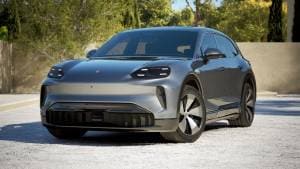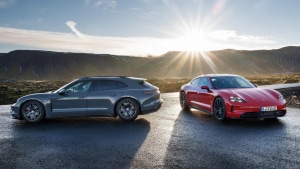2017 Porsche Panamera Turbo first drive review
Porsche is, among many things, one of the leaders in the automobile industry when it comes to sheer engineering. Their cars do things that defy the logic of what should be possible. Case in point, the previous Panamera, a giant of a luxury saloon that was convinced it was a sportscar. The way that car went around corners was shocking, 1.9 tonnes of metal has no business changing direction that rapidly! But there was a problem the Panamera was a striking car but that humpback rear wasn't easy on the eyes. It certainly wasn't what you'd call a pretty machine. Thankfully, that's changed with the all-new model.
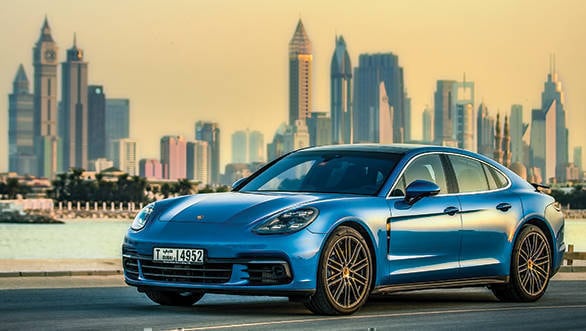
Design, style and features
When Porsche says all-new, they mean it. Every single thing is changed, save for the iconic company logo. But more importantly, Porsche has achieved with the new Panamera what the old one lacked - it finally looks like a four-door 911! The roofline from the top of the A-pillar descends in a continuous and graceful arc all the way till the new 911-like tail lamps. The front wheel has been repositioned further forward, improving the stance and the side is characterised by two clean lines that emerge from the vent behind the front wheel. Viewed head-on, the Panamera looks even wider thanks to a long and wide intake in the bumper and new accent lines in the hood. An actual 6mm increase in width further enhances the effect.
 The side profile now looks quite a bit like a four-door 911
The side profile now looks quite a bit like a four-door 911

The big, full-LED headlamps feature Porsche's trademark four LED spots and have a matrix function similar to Audi's headlamps. Each headlamp uses 84 individual LEDs which allow an intelligent high beam system that can cut individual LEDs around on-coming traffic. Porsche says this is the new lighting benchmark. As with the new 718 Boxster and Cayman, the rear gets 3D tail lamps connected by a thin reflective strip that increases the sense of width. And of course, there's Turbo's biggest party trick - a recessed, three-piece rear wing that folds out when deployed so as to offer more surface area.
There's a world of difference on the inside. What was once a huge collection of buttons now sees a clean black touch-sensitive glass panel as the centre console. There are very few physical buttons; the upside being that there aren't any ugly plastic blanks to be seen if you aren't keen on blowing the serious cash that Porsche's optional extras demand. It takes some getting used to but the touch system works. Helping you get some feedback is a physical sensation of a depression when you press it, a similar sensation to the iPhone's home screen button. It's a nice way to know if the button has registered your input but takes a bit more effort than I'd have liked.
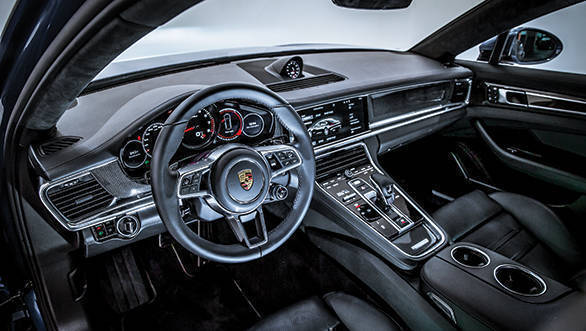 The Panamera gets a high-tech new interior where touch panels replace most of the physical buttons
The Panamera gets a high-tech new interior where touch panels replace most of the physical buttons
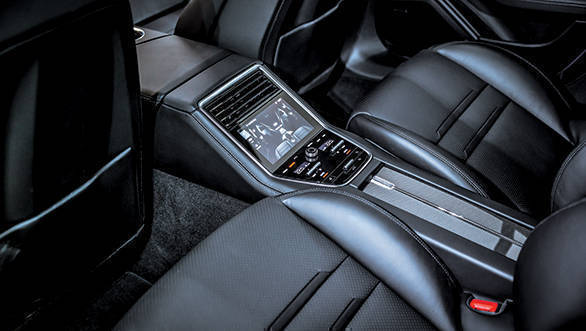 Rear passengers are separated by an extension of the front centre console
Rear passengers are separated by an extension of the front centre console
Above the touch panel is a long and beautiful high-resolution touchscreen display that resides in the sleek leather-wrapped dashboard. This screen occupies the traditional space of the central air vents, so Porsche has relocated them and split them into two sections. The first sits atop the dashboard and is controlled by thumb-operated slide adjusters. The second set of vents are positioned at the top of black touch panel, just below the infotainment screen. These are more interesting because they don't offer manual adjustment. Instead, you have to choose the Climate menu in the infotainment system, then choose 'vents', which gives you access to a digital slide controller for the central vent. Using your finger, slide left-right or up-down for corresponding movements in the air vents. Both the driver and passenger get split control sections for their respective vents. It's futuristic but far more tedious and time-consuming than standard physical controls.
The central glass panel flows continuously into a space for cupholders and a stowage bin before concluding in another console for the rear passengers. This console houses a high-resolution screen above another pair of digitally controlled vents and a similar glossy black touch panel. Stepping into the rear reminds that this isn't just a sportscar, it's also a high-end luxury saloon. The two seats offer generous kneeroom but I was seriously impressed with how much headroom there was despite the sporty new roofline. The seats are very comfy, the squabs extend forward and the backrests recline. Rear space and comfort is now very generous, and I imagine it will be truly opulent on the long-wheelbase Panamera Turbo Executive that has an additional 150mm between the front and rear axles.
Engines and performance
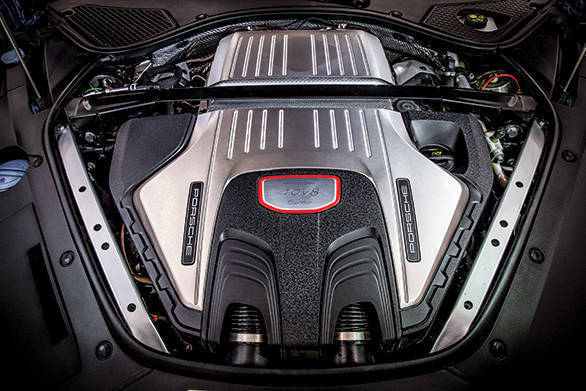 New 550PS twin-turbo V8 is a bomb, sounds great too!
New 550PS twin-turbo V8 is a bomb, sounds great too!
Porsche has a comprehensive range of engines in the Panamera line-up but India gets the mighty Turbo first, so that's what we'll focus on. A brand new, twin-turbo, 4.0-litre, V8 petrol, this engine hammers out 550PS and 770Nm that peaks from 1,950rpm to 4,500rpm. Claimed performance is outrageous. 0-100kmph takes 3.8s which drops to 3.6s if the car is equipped with the optional Sport Chrono package. Let that sink in, that's a 2-tonne car accelerating harder than some supercars can manage... Top speed is just over 300kmph and in-gear performance is ferocious.
There's a huge amount of tech that makes this motor tick. It features a new, hot-in-vee turbo layout where the two turbos are nestled within the two cylinder banks with the exhaust ports facing inward. The layout brings many benefits including better control over the turbos, faster responses and more compact packaging. Then, there's the new cylinder deactivation tech that cuts off the second, third, fifth and eight cylinder by a sliding cam system that deactivates the valve gear. When the motor is between 950-3,500rpm and less than 250Nm is required, the Panamera turns into a 4-cylinder engine with a 30 per cent jump in efficiency. There's also a new 8-speed PDK double-clutch gearbox that offers improved smoothness and a claim of even faster shift times than the already incredible 7-speed PDK.
Ride and handling
 A short slalom course highlighted the Panamera's incredible agility
A short slalom course highlighted the Panamera's incredible agility
Unfortunately, our drive experience of the Panamera was restricted to a rather pointless drone down Dubai's arrow-straight highways with a maximum speed of 120kmph. For now, I can authoritatively tell you that the Panamera cruises very well at 120kmph on smooth roads. Driving the car in India will reveal far more. The Panamera's trump card, however, is its dual offering of luxury feel and sportscar performance. Just how fast is this thing? Here's some perspective the new Panamera Turbo laps the Nurburgring in 7:38s which is 2s quicker than the last-generation 911 GT3. That's a 450PS, lightweight track-special version of the 911 that weighed about 600 kilo less. I know unbelievable, right?
In an attempt to give us a taste of this phenomenal handling potential, Porsche took us to the parking lot of a rugby stadium where they set up a short slalom course. Again, not much could be gleaned from this 30-second blast through some cones except that the Panamera has freakish agility, no doubt aided by the optional rear-wheel steering system. From behind the wheel, the responses feel physically impossible for a car this large. Same goes for watching other journalists blast around the course - it just seems wrong watching such a large car change direction so hard, fast and flat. My mind is blown; Porsche really have engineered something incredible here and I can't wait to experience it on a proper winding road.
Conclusion
At a starting price of about Rs 1.93cr for the Panamera Turbo and Rs 2.05cr for the long-wheelbase Turbo Executive, the Panamera offers a mind-bending mix of supreme luxury and incredible sportscar performance. No other car has taken the luxury-super saloon game this far ahead. How it fares in India remains to be seen but there's no doubt that this car is a stupendously impressive machine.
Starts Rs 1.45 Crore
3996cc
Automatic
689
770
10.75 Kmpl
Starts Rs 86 Lakhs
1988cc
Automatic
300
380
-NA-
Starts Rs 1.38 Crore
3996cc
Automatic
350
460
8 Kmpl
